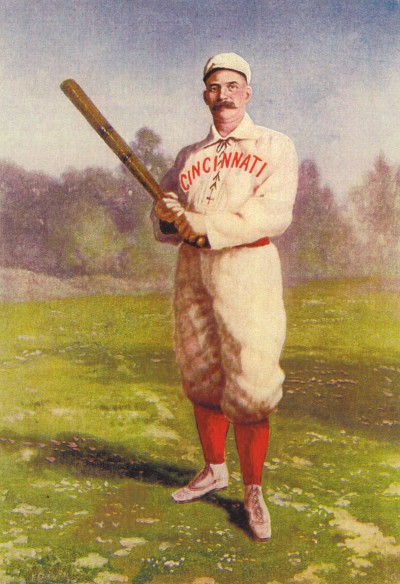
Cal McVey, born on Aug. 30, 1849, became the youngest player on the first professional baseball team; the Cincinnati Red Stockings of 1869.
By Don Doxsie
The game of baseball had already been played in some form for many centuries, but in the middle stages of the 19th century it became especially prevalent in the large cities along the East Coast of the United States. The American Civil War, which lasted from 1861 through 1865, became the tipping point in its development.
A game that had mostly been played in small pockets here and there with varying sets of rules became very popular among the soldiers in camps and during leisure times between battles. When the soldiers went home following the war, they took baseball and a somewhat standardized set of rules with them, and it spread throughout the country.
Amateur and club teams popped up all over the landscape and inevitably the competitive drive to be the best led teams to pay players. At first, it was a covert practice. Teams would slip a few dollars to a top player under the table to play for their club. But in 1869, a team called the Cincinnati Red Stockings decided to begin openly paying salaries to players.
It was the birth of professional baseball as we know it today.And an Iowa native named Cal McVey was a big part of it.
McVey, born near the small town of Montrose, just north of Keokuk in the extreme southeast corner of Iowa, became the youngest player on the original Red Stockings at the age of 19. He also was the only player on the team born west of the Mississippi River.
He was destined to become one of the best players in the first decade of professional baseball, a .346 career hitter who played every position on the field at one time or another. It’s difficult to compare the statistics of that time to later eras of the sport. The rules were different, the seasons were shorter, the equipment was much more primitive. Batters could demand to have the pitcher throw the ball in a certain spot, usually underhanded. The fielders did not wear gloves. Nevertheless, .346 was an exceptional average in any era.
McVey was born in 1849 to William and Caroline McVey, who came from Indiana to find a new life farming in a territory that did not become a state until three years before Cal’s birth.Montrose actually had been settled about 60 years earlier and had been the site of Fort Des Moines in the 1830s. From 1839 to 1846, it was inhabited by many of the founding members of the Church of Jesus Christ of Latter Day Saints, also known as the Mormons, who were building a permanent settlement just across the Mississippi River in Nauvoo, Ill.
The McVeys struggled to find prosperity in farming in Montrose and finally moved back to Indianapolis in 1860 when Cal was 11. William McVey found work there as a piano tuner and tax collector.
It was around that time that Cal McVey discovered baseball. At 5-foot-9 and 170 pounds, he was fairly average in size but his athleticism was obvious. Some felt he could have had a career in boxing and he also displayed gymnastic ability. In ensuing years, when the baseball teams for which he played were victorious, it was not uncommon for him to celebrate by doing handsprings or cartwheels as he left the field.
TO READ MORE ABOUT THIS STORY AND OTHER FASCINATING STORIES ABOUT IOWA HISTORY, subscribe to Iowa History Journal. You can also purchase back issues at the store.
